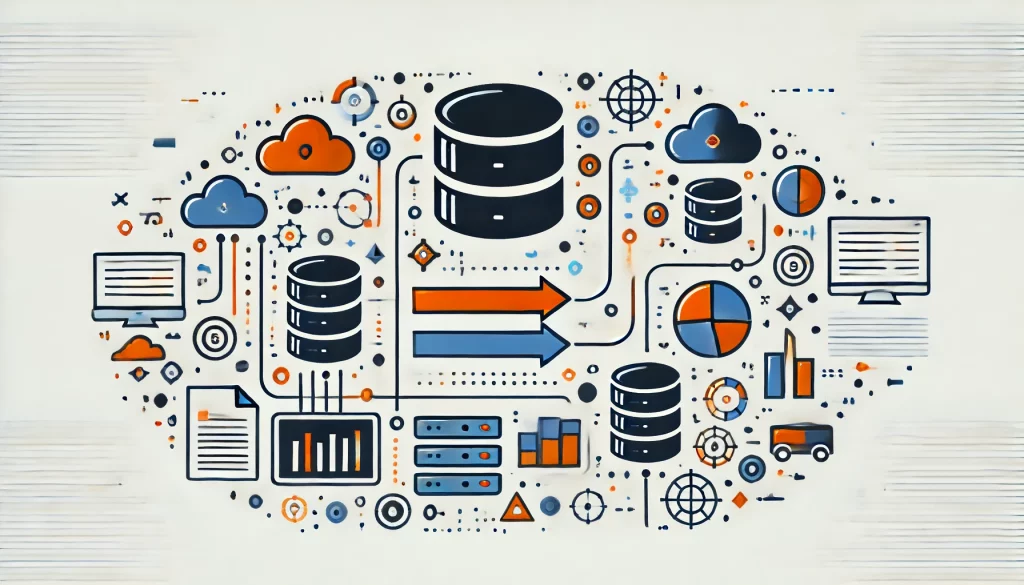
Data Migration Simplified: Types, Best Practices, and Challenges

Data migration is a crucial process that involves moving data from one storage system to another. While the concept may seem straightforward, the actual process can be complex and challenging. When moving data to a new database or cloud platform, make sure to prioritize keeping your information safe and secure.
This is especially important if transferring from an unsupported storage solution. In this article, we will discuss data migration, including types, process, challenges, and best practices for a successful migration.
Types of Data Migration
Several types of data migration exist, each with its own unique characteristics and requirements.
Storage Migration
Storage migration involves moving data from one storage location to another. This process includes validating, duplicating, and cleaning data. The duration of the migration depends on the volume of data being transferred. Organizations often undergo storage migration to gain technical advantages, such as increased scalability and access to innovative features, rather than simply expanding storage capacity.
Database Migration
Database migration involves moving data from one database to another or upgrading an existing database. When migrating between different database engines, careful planning is essential, as there may be significant differences in data structures. For example, the source database might be relational, while the target is non-relational, or vice versa.
Application Migration
Application migration involves moving software programs from one operating environment to another. An organization often moves important business applications from their own data center to public cloud servers. The differences in data models, specifications, and configurations between computing environments can pose challenges during the migration process. Middleware products can help bridge the gap between different technologies, maintaining a smoother migration.
Data Center Migration
A data center serves as a company’s control hub, housing critical data, applications, and software. Data center migration is moving data from one data center to another. This can be to a new data center or a cloud platform.
This type of migration becomes necessary when a company’s needs have outgrown its current data center. Given the extensive nature of this process, thorough planning and assessment are crucial to ensure data safety.
Business Process Migration
Business process migration involves moving business applications, metrics, and process data to new environments. This typically includes migrating products, services, customer data, and operational information. Business process migrations often happen during mergers, acquisitions, or when changing business models to enter new markets.
Cloud Data Migration
Cloud migration involves moving data from local storage to the cloud, including all operations and processes. It can also involve moving data from one cloud provider to another. Companies use cloud services like AWS, Google Cloud, or Microsoft Azure to store and handle data. This helps them scale easily, perform better, save on maintenance costs, and potentially save money on data storage.
The Data Migration Process
The data migration process consists of several key phases, including planning, migration design, execution, and testing.
Planning Phase
The planning phase is crucial for a successful migration. It involves evaluating existing data assets and creating a suitable migration plan. Key steps in this phase include:
- Refining the scope: This step removes extra data and determines the least amount needed for the new system to work well. To successfully migrate data, you must analyze the source and target systems. You should also consult with the users impacted by the migration.
- Assessing source and target systems: It is important to carefully evaluate the operational requirements of the source system. Then, analyze how to adapt these needs for the new environment.
- Setting data standards: Setting data standards helps teams find issues during migration and prevent problems after migration.
- Estimating budget and timeline: After narrowing down the scope and assessing the systems, you can choose how to migrate. You can do this gradually or all at once. Determine the resources needed and establish achievable timelines. According to Oracle, an enterprise-scale data migration project typically lasts between 6 and 24 months.
Migration Design Phase
The migration design phase defines essential aspects such as migration and testing rules, acceptance criteria, roles and responsibilities, and data migration technologies.
Extract, Transform, and Load (ETL)
ETL is an integral part of the data migration process. Various technologies can perform this process. Projects with complex data flows and large data volumes usually need an ETL developer or software engineer. These professionals can either customize third-party ETL tools or create scripts for data transition.
Data Mapping
Data mapping is an important part of ETL. Data mapping is a key aspect of ETL. It involves a team of professionals, including an ETL developer, a system analyst, and a business analyst.
The system analyst is familiar with the source and target systems. The business analyst understands the value of the data being transferred.
The time it takes to plan migration depends on writing scripts for ETL or getting automation tools. If you already have the required software in place and only need to customize it, this phase can take a few weeks. Otherwise, it can span several months.
Execution and Testing Phase
The execution and testing phase involves implementing the previously designed ETL processes. A big bang migration usually lasts a couple of days, while a trickle approach can take longer. However, the trickle strategy has the lowest risk of critical failures and ensures zero downtime.
Best practices for execution and testing include:
- Ensuring that migration processes do not hinder normal system operations during a phased migration. The migration team needs to keep talking to different business units to decide which users should get each sub-migration first.
- Continuous testing rather than treating it as a separate phase. You should carry out testing across all phases, including design, execution, and post-migration. In a trickle approach, test each portion of the migrated data to remediate issues in a timely manner.
- We regularly test to ensure that we transfer data safely to the target infrastructure. The team conducts testing according to predefined requirements. The system also transfers the data at a high quality.
Common Data Migration Challenges
Data migration projects often face several challenges that can interfere with the process, such as:
Risk of Business Disruption
Organizations try not to stop production during migration to avoid downtime and keep all systems running smoothly. However, achieving this can be challenging. Another risk is that changes to data during the migration process may lead to system inconsistencies and inaccurate data.
Risk of Data Loss or Corruption
Minimizing the risk of data loss or corruption is a key objective during the migration process. Data loss can occur due to various reasons, such as incomplete or inaccurate transfer, system incompatibility, or human error. The consequences of data loss can be severe, including financial losses, and compliance violations.
Risk of Exposure
Data breaches pose a serious risk during the migration process. As data moves, the system and the data itself become more vulnerable. Hackers exploit vulnerabilities in data transfer or storage to manipulate or steal data during migration. This can lead to data migration failure or corruption.
Data Migration Strategies
Several data migration strategies organizations can employ, depending on their specific needs and requirements.
“Big Bang” Migration
The big bang approach completes the data transfer within a limited time. ETL processes the data and migrates it to a new database, causing downtime on the production system.
The advantage of this approach is that everything happens in a single time-boxed event. However, the pressure can be high, as the business operates with a critical resource offline. If the big bang approach is best for your organization, it’s advisable to run a realistic test of the migration process before the actual event.
“Trickle” Migration
Trickle migration completes the process in stages, with old and new systems running in parallel to eliminate downtime. Real-time processes keep data synchronized between the two environments. Although more complex, well-designed implementations can reduce risk compared to the big bang approach when executed correctly.
Lift and Shift
The lift and shift migration moves an application and its data to the cloud without making many changes. The application will continue to work the same way and will handle the data in a similar fashion. If the application doesn’t need changes, you can move it to a new location without making any adjustments.
You should plan a lift and shift migration, considering the application’s network, computing, and storage requirements. It involves mapping from the available resources in the source infrastructure to the cloud provider’s resources. Most cloud vendors offer on-the-fly upgrades to ensure customers can start with a smaller product and scale as needed.
Best Practices for Successful Data Migrations
To ensure a successful migration, consider the following best practices:
Explore and Assess the Source
Calculate and analyze the volume of data that is being collected and its characteristics.
Different data fields exist. Some do not need mapping to the target system. Other people may be missing and someone needs to find them elsewhere to fill in the gaps.
Ask yourself what needs to migrate, what you can leave behind, and what is missing. Skipping the source review step and assuming you have all the data can result in a costly and lengthy migration process. Moreover, organizations can experience serious flaws because of data mapping issues, potentially halting the migration entirely.
Develop a Solid Data Backup and Protection Plan
Consider the possibility of an incomplete or incorrect migration. Regularly back up your data and use tools and techniques to protect it from various error scenarios. This is useful if a file breaks during moving or if data disappears or is incomplete for unknown reasons. Map your data to destinations so team members can easily track its origin, destination, transfer process, and timing.
Test and Validate Migrated Data
After a successful migration, validate that all data is where it should be. Clean out old data and ensure that you apply permissions correctly. Backing up the old system is smart. If the new one fails, you can still access it from a secure location.
Audit and Document Processes
Comprehensive documentation of the data migration process is critical for compliance in regulated industries. Regulators may need proof that proper controls are in place for sensitive data, like financial or medical information. The documentation should indicate if the migration was successful and highlight areas for improvement in future migrations.
Conclusion
Data migration is a complex process that requires careful planning, execution, and testing. Knowing different data migration types, challenges, and best practices is crucial for organizations wanting to migrate data successfully. Organizations can ensure a smooth and secure data migration by using the right tools and strategies. This helps minimize the risk of business disruption, data loss, or exposure.
Before you begin a data migration project, make sure to assess your needs and requirements. This will help you select the most suitable migration strategy. Whether you opt for a big bang approach, a trickle migration, or a lift and shift method, thorough planning and testing are key to avoiding common pitfalls and ensuring a successful outcome.
To keep data safe during migration, organizations should review the source data carefully. They should also create a backup plan and test the migrated data.
Additionally, it is important to document the process. This helps reduce risks and maintain data integrity and security. This helps reduce risks and maintain data integrity and security.
As data grows, moving it effectively will stay crucial for modern businesses. Organizations can successfully manage data migration by staying up-to-date on the latest tools, techniques, and best practices.
